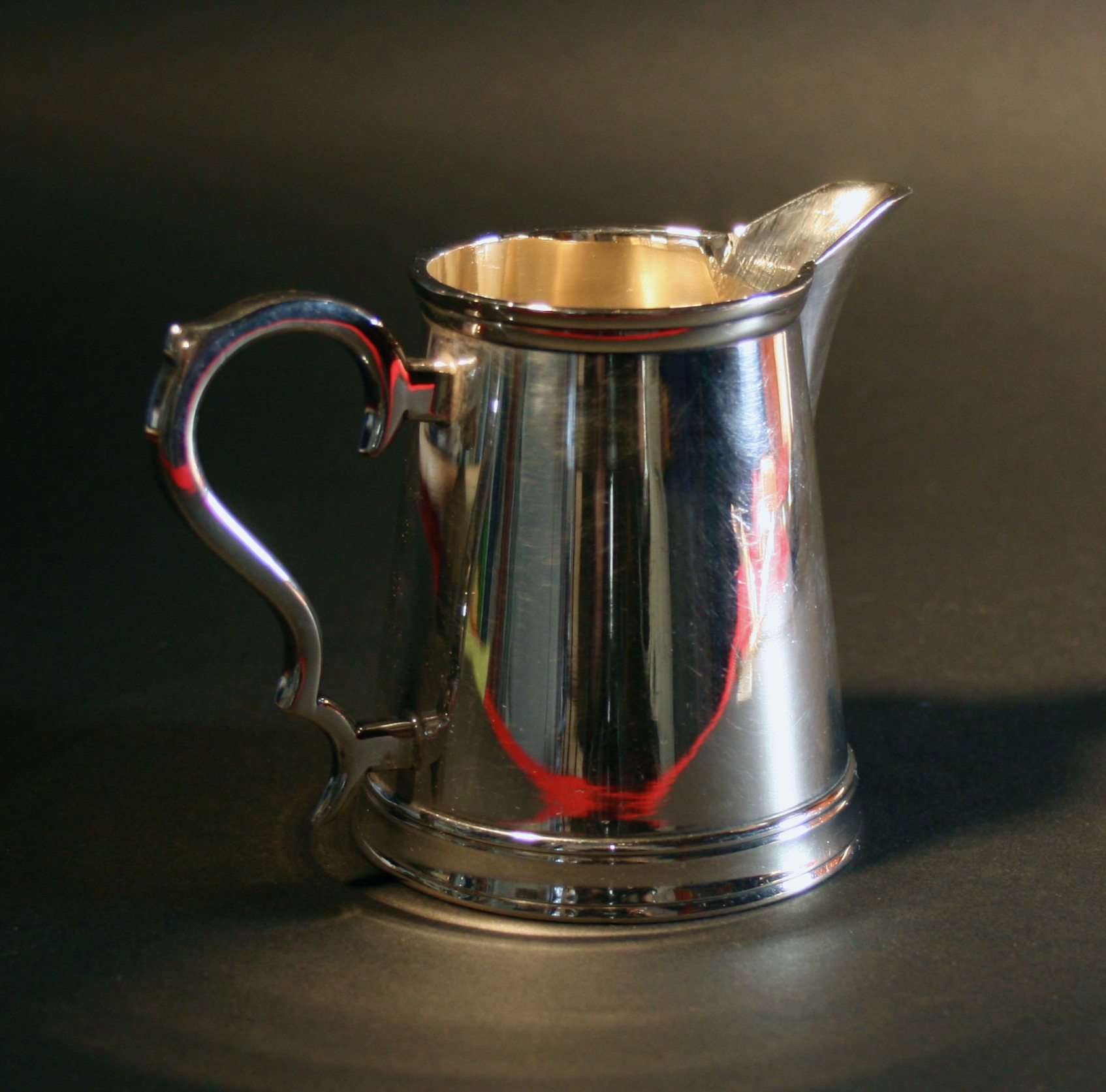

Title: Vintage Luxury Silver Tableware Creamer Cup
Shipping: $29.00
Artist: N/A
Period: 20th Century
History: Art
Origin: Central Asia > India
Condition: Very Good
Item Date: N/A
Item ID: 515
This beautiful silver handmade creamer cup appears to be part of a heavy silver table set, intended for serving creamer alongside coffee or tea. It has been skillfully crafted by a Silversmith Master, exhibiting exquisite workmanship. This piece exudes an aura of wealth and success. The silver marks look like they were created in India. I believe this cup was made somewhere in the mid-20th century. The height is H 3" 1/4 of an inch the width is 4" 1/4 inches. If you have any questions please inquire. The history of silversmithing in India is rich and spans several centuries, dating back to ancient times. Indian silver smiths have a long-standing tradition of creating intricate and ornate silverware, jewelry, and artifacts that reflect the country's diverse cultural heritage. The roots of silver smithing in India can be traced back to the Indus Valley Civilization, which flourished around 3300 to 1300 BCE. Archaeological excavations have unearthed silver artifacts, indicating that the craft of working with silver was well-established even during this ancient period. Over the centuries, the art of silver smithing evolved and flourished under the patronage of various dynasties and empires that ruled the Indian subcontinent, including the Mauryas, Guptas, Mughals, and several regional kingdoms. Each era and region contributed its unique style and techniques to silver smithing. During the Mughal period (1526-1857), silver smithing reached its zenith. The Mughal emperors and nobility were great patrons of the arts, including silver craftsmanship. The intricate designs and patterns of Mughal silverware are highly admired for their artistic brilliance. Silversmiths in India have traditionally been organized into guilds or communities, passing down their knowledge and skills from one generation to the next through an apprenticeship system. These skilled artisans create a wide range of silver items, including utensils, tableware, jewelry, idols, and religious artifacts. One of the most famous centers of silver smithing in India is the city of Jaipur in Rajasthan. Known for its exquisite silver jewelry and artifacts, Jaipur has become a hub for both traditional and modern silver craft. In modern times, the art of silversmithing in India has faced challenges due to the advent of mass-produced items and changes in consumer preferences. However, there is still a strong demand for authentic handcrafted silverware and jewelry, both domestically and internationally, which helps keep this ancient tradition alive. Today, silversmithing in India continues to be an essential part of the country's cultural heritage, and artisans strive to preserve and innovate upon their traditional craft, ensuring that the legacy of Indian silver smithing endures for generations to come.
The history of silver and metalworking in India is a fascinating journey that spans millennia and showcases the country's rich cultural heritage and artistic prowess. Indian artisans have been renowned for their skill in working with various metals, including silver, gold, copper, bronze, and iron. Let's delve into the history and techniques of silver and metalworking in India: 1. Ancient Times: The roots of metalworking in India can be traced back to the Indus Valley Civilization (around 3300 to 1300 BCE). Archaeological excavations have revealed metal artifacts, such as copper tools and ornaments, indicating the early existence of metalworking in the region. 2. Bronze Age: During the Bronze Age (2000 to 500 BCE), metalworking techniques continued to evolve. The use of bronze, an alloy of copper and tin, became prevalent, and artisans created a wide range of bronze objects, including ritualistic artifacts, figurines, and utensils. 3. Iron Age: With the advent of the Iron Age (around 1000 BCE), ironworking techniques gained prominence. Iron tools, weapons, and implements became crucial in various aspects of life, from agriculture to warfare. 4. Maurya and Gupta Periods: During the Maurya (322 to 185 BCE) and Gupta (320 to 550 CE) periods, metalworking reached new heights. The patronage of the ruling dynasties and the emergence of skilled artisans led to the creation of intricate metal sculptures, statues, and religious artifacts. 5. Medieval Period: The medieval period saw significant advancements in metalworking techniques, especially during the reign of the Delhi Sultanate (1206 to 1526 CE) and the Mughal Empire (1526 to 1857 CE). Mughal emperors were great patrons of the arts, and metalworking flourished under their support. Silver and gold jewelry, ornate utensils, and decorative artifacts displayed exceptional craftsmanship. 6. South Indian Metalwork: In the southern regions of India, particularly in states like Tamil Nadu and Karnataka, there was a flourishing tradition of metalwork, especially in bronze. Skilled artisans crafted intricate bronze sculptures of gods, goddesses, and mythological figures. The lost-wax casting technique (cire perdue) was commonly employed to create these masterpieces. 7. Silver Filigree Work: One of the prominent silverworking techniques in India is filigree work, where delicate and intricate designs are made by twisting and soldering thin silver wires. Cities like Cuttack in Odisha and Karimnagar in Telangana are renowned for their exquisite silver filigree craftsmanship. 8. Bidriware: Bidriware is a unique metalworking technique that originated in the city of Bidar, Karnataka. It involves the use of zinc-copper alloy, which is inlaid with silver or gold designs. The resulting objects, such as vases, bowls, and jewelry, display a striking contrast between the blackened metal background and the shiny silver or gold patterns. 9. Modern Times: Despite facing challenges from modern manufacturing methods, traditional metalworking techniques in India continue to thrive, particularly in regions where the craft has been passed down through generations. Artisans still produce intricate metal jewelry, sculptures, utensils, and decorative items that blend ancient techniques with contemporary designs. Indian metalworking represents a treasure trove of artistry and craftsmanship, reflecting the nation's deep-rooted cultural diversity and artistic heritage. These skilled artisans play a vital role in preserving and passing on this legacy to future generations, ensuring that the traditions of metalworking in India endure for years to come.